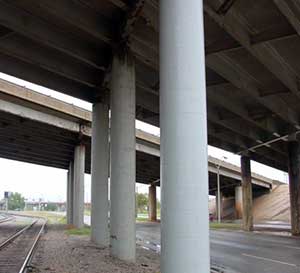The State of Our Nation’s Bridges: Time for Repair and Renewal A recent report from Transportation for America paints a troubling picture of the condition of our nation’s bridges. More than 18,000 bridges in urban areas are classified as structurally deficient. In cities like Los Angeles, an average of 396 vehicles pass over a deficient bridge every single second. This staggering statistic really highlights just how big this problem is. To put it into context, there are actually more deficient bridges in just metro areas alone than the total number of McDonald’s locations across the entire U.S., according to James Corless, the director of Transportation for America. And what’s even more alarming is that 75% of all the traffic in busy urban centers crosses one of these substandard bridges every day. According to Transportation for America, a deficient bridge is one that has surpassed its recommended lifespan of 42 years. Many of the bridges we rely on most frequently today were built more than five decades ago. This report, titled “The Fix We’re In For: The State of Our Nation’s Bridges,†comes shortly after the unexpected closure of a crucial commuter bridge in Louisville, Kentucky. Inspectors discovered two critical cracks in the load-bearing part of the bridge, prompting its immediate shutdown. This left around 80,000 daily commuters scrambling to find alternative routes. This unsettling report serves as a stark reminder of the tragedy that occurred on August 1, 2007, when the I-35 bridge in Minneapolis collapsed, causing injuries and fatalities. That bridge had been constructed in 1967, and the city’s population had grown by 42% between 1990 and 2003. Over the years, both taxpayers and elected officials have largely ignored the urgent need for proper maintenance and modernization of our aging infrastructure. However, investing in transportation and infrastructure has always been a key driver of economic growth. Such investments create jobs, improve connectivity for people, goods, and services, ease traffic congestion, lower fuel costs, and ultimately save lives by ensuring that critical structures are properly maintained and repaired. One major challenge lies in the distribution of federal funding. It’s surprising to learn that states can legally divert up to half of their federal funds earmarked for bridge repairs to other projects without any accountability. Transportation for America recommends channeling more resources to states specifically for bridge repair while enforcing strict guidelines to ensure these funds are used solely for bridge maintenance. To maximize taxpayer dollars, focusing on repair rather than replacement is crucial. Methods that provide long-term solutions include the use of carbon fiber repair systems, such as those provided by HJ3 Composite Technologies. Carbon fiber has proven effective in restoring bridges and could significantly extend the life of many bridges nearing or exceeding their expected lifespans. Rebuilding these structures from scratch would not only be costly but also unnecessary. With proper upkeep, their lifespan could be extended by 50 to 100 years. HJ3, a respected leader in the composites industry, is renowned for its excellent reputation, top-notch products, engineering expertise, and on-site quality control. Allowing roads and bridges to deteriorate over time ends up costing state and local governments billions more than regular, timely maintenance and repair of these vital assets. If you’d like to explore how HJ3’s carbon fiber solutions can make a difference in your state, feel free to reach out to HJ3 at [insert contact information] or call 1-877-303-0453. X56 Ssaw Pipe,Api X56 Ssaw Pipe,Api Spiral Steel Pipe Hydrogrand Steel Pipe Co.,ltd , https://www.hydrograndtube.comThe Fix We’re In For

These Overpass Supporting Columns Have Been Strengthened with HJ3's FRP System
â€